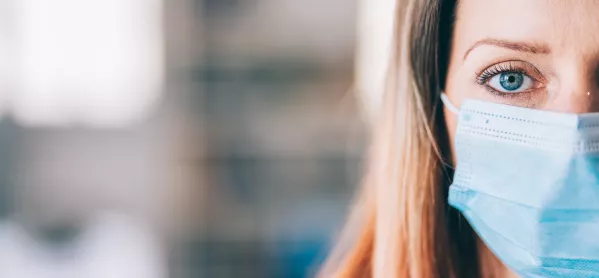Schools told when to ‘think about’ extra Covid measures

The Department for Education (DfE) has updated its Covid contingency framework for schools with suggestions on how and when to tackle outbreaks.
It says, for most settings “it will make sense to think about taking extra action if the number of positive cases substantially increases”.
Related: Revealed: The new Covid contingency plans for schools
Contingency framework: Schools told to plan for more remote learning
Exclusive: How DfE scrapped its previous system for managing Covid in schools locally
‘Thresholds’
There are two suggested “thresholds” for when schools may consider to have reached this point, the guidance says.
For most schools, this is whichever is reached first out of:
- Five children, pupils, students or staff, who are likely to have mixed closely, test positive for Covid-19 within a 10-day period.
- 10 per cent of pupils, students or staff who are likely to have mixed closely test positive for Covid-19 within a 10-day period.
For special schools, residential settings and settings that operate with 20 or fewer pupils, students and staff at any one time, the threshold is:
• Two pupils, students and staff, who are likely to have mixed closely, test positive for Covid-19 within a 10-day period.
‘Close mixing’
Identifying a group that is likely to have mixed closely will be different for each setting, the document says, but “will rarely mean a whole setting or year group”.
For schools, it could include a form group or subject class, a friendship group mixing at breaktimes, a sports team or a group in an after-school activity.
Extra Covid measures to consider
When the above thresholds are reached, schools “should review and reinforce the testing, hygiene and ventilation measures they already have in place”, according to the guidance.
Schools should also consider:
- Whether any activities could take place outdoors, including exercise, assemblies or classes.
- Ways to improve ventilation indoors where this would not significantly impact thermal comfort.
- One-off enhanced cleaning, focusing on touch points and any shared equipment.
If a director of public health or a health protection team judges that additional action should be taken, they may advise that settings take extra measures, such as:
- Strengthened communications to encourage pupils/students to undertake twice weekly rapid asymptomatic home testing and reporting.
- Temporarily reinstating face coverings for pupils/students, staff and visitors in indoor and/or communal spaces in secondary schools, further and higher education settings, and for staff in primary, early years, out-of-school, and specialist settings. This should be for two weeks in the first instance, pending regular review.
- Reinstating on-site rapid lateral flow device testing in secondary schools, colleges and universities for a two-week period to encourage uptake of twice-weekly testing.
- Increased frequency of testing.
In “extreme cases”, and as a last resort, schools may be advised to introduce short-term attendance restrictions in a setting, such as sending home a class or year group.
Existing Covid rules for schools from September
The above extra measures come on top of existing rules for schools from September, which include:
1. Students in secondary schools and colleges should be tested twice on site on return in the autumn term. The tests should be between three and five days apart.
2. Thereafter, staff and students in secondary schools and colleges, and staff in primary schools, should test themselves twice a week at home until the end of September, when this will be reviewed.
3. Those who test positive should isolate, take a confirmatory polymerase chain reaction (PCR) test, and continue to isolate if the result is positive.
4. Schools and colleges need to be prepared to implement high-quality remote learning arrangements.
5. Under-18s will not need to self-isolate if they are a close contact of a positive case. They will be strongly advised to take a PCR test and, if positive, will need to isolate.
6. 18-year-olds will be treated in the same way as younger students until six months after their 18th birthday, to allow them the opportunity to get fully vaccinated (double-vaccinated adults do not need to isolate either).
7. All schools should continue to maintain appropriate cleaning regimes, keep occupied spaces well ventilated, and follow public health advice on testing and managing confirmed cases of Covid-19.
8. There should continue to be “strong messaging” about signs and symptoms, isolation advice and testing, to support prompt isolation of suspected cases.
You need a Tes subscription to read this article
Subscribe now to read this article and get other subscriber-only content:
- Unlimited access to all Tes magazine content
- Exclusive subscriber-only stories
- Award-winning email newsletters
Already a subscriber? Log in
You need a subscription to read this article
Subscribe now to read this article and get other subscriber-only content, including:
- Unlimited access to all Tes magazine content
- Exclusive subscriber-only stories
- Award-winning email newsletters
topics in this article



